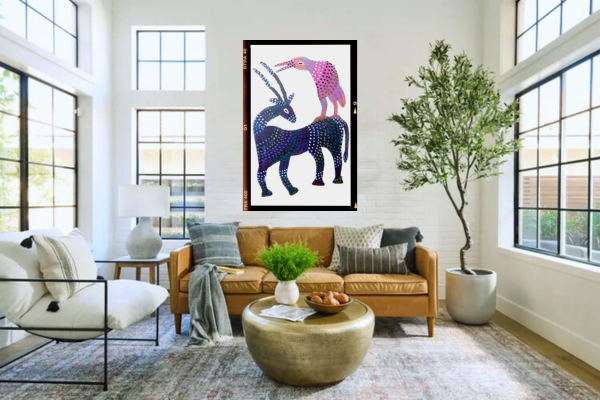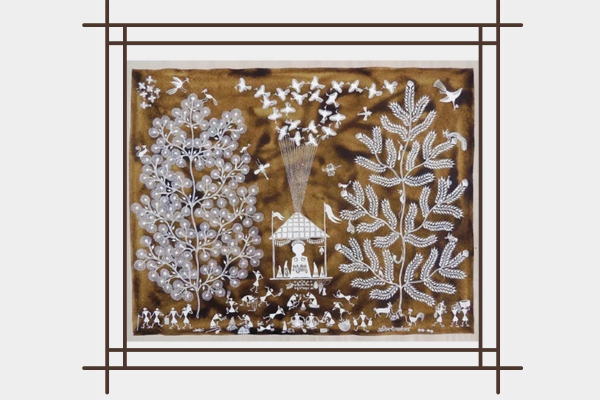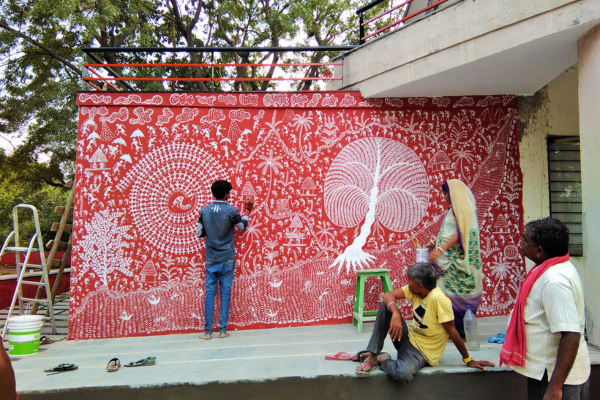Why Indian Folk Art is Gaining Popularity as Handmade Wall Décor
Over the past few years, there has been a lovely resurgence of love for traditional hand-crafted goods, particularly in the interior design market. Leading ahead in this trend is Indian folk art—a rich, highly symbolic representation of India's cultural heart. Previously limited to rural dwellings and tribal ceremonies, these artworks now find themselves on modern walls, recounting eternal tales while infusing modern spaces with beauty and significance.

Indian folk art, Bhil Art painting by artist Ladoo Bai, is used as modern wall décor (gallery unique art)
The Enduring Charm of Indian Folk Art
Indian folk art is a goldmine of different styles and traditions, each having been passed down through the generations. These paintings are not just pretty to look at—they are true reflections of rural cultures, filled with mythology and born out of everyday rural life.
Whether it's the nature-based dot work of Bhil paintings, the symbolic stick human figures in Warli art, or the sacred symbolism of ancient religious artwork, each is filled with tradition and depth.
More so, these artworks are significantly distinguished from modern metal-incorporated artworks, as they are environmentally friendly creations. Created from natural materials such as plant-based colours, cow dung, and hand-crafted paper, these art pieces resonate with today's increasing need for sustainability.
Why Indian Folk Art is Trending in Modern Décor
1. A Global Shift towards Sustainability and Handicrafts
With conscious living being the new way of life, Indian folk art has a ready welcome in eco-conscious homes as home decor articles. The present interior styles are abandoning mass-produced, impersonal furnishings and gravitating toward ethically produced, sustainable, and handmade items. Indian folk art fits perfectly into their ethos.
Their hand-painted nature and narrative potency ensure they are irresistible to designers and collectors looking for items with character and heritage.
2. A Cultural Reawakening of Identity and Pride
As people look back on their heritage, there is an increasing sense of pride in celebrating India's vibrant cultural heritage. Decorating with folk art—Bhil, Warli, or Madhubani—is more than mere design. It's an act of respect for our past, preservation of native customs, and patronage for the artisans who propagate them.
3. Aesthetic Versatility: Simple yet Soulful
Folk art seamlessly incorporates the new and the old. Such styles as Warli, with its spare monochromatic colour and geometric motifs, sit beautifully alongside contemporary, Scandinavian, or bohemian-inspired décor. These pieces bring personality without dominating the room—heritage in simplicity.
4. Global Recognition and Accessibility
From global art fairs to websites such as Instagram and Etsy, Indian folk art has been recognized worldwide and appreciated by everyone. People all over the globe are learning about its beauty and originality, bestowing Indian tribal artists with long-awaited recognition and a stage to prove themselves.
Popular Indian Folk Art Styles for Wall Décor
Bhil Art
A tradition originating in the Bhil tribe of Madhya Pradesh, Bhil Art paintings are renowned for their vibrant hues and dotted patterns. The paintings typically depict images of day-to-day tribal life, flora, fauna, and religious beliefs.

Traditional Bhil folk art painting from Madhya Pradesh (gallery unique art)
Enhance your space with tradition—buy authentic Bhil art painting and bring home the soulful elegance of Indian folk culture.
Warli Painting
From Maharashtra’s Sahyadri region, Warli art is one of India’s oldest and most minimalist art forms. Made with rice-paste-based white pigment on a contrasting earthy background, warli art painting depict community life—farming, festivals, marriage rituals, and dances. Its naïve charm and visual storytelling resonate strongly with today’s design lovers. Warli’s linear, symbolic design fits seamlessly into hallways, offices, and living rooms, making it a versatile and elegant choice.

Warli folk painting for modern homes(gallery unique art)
Add a splash of vibrant tradition—shop original Warli art paintings here and celebrate the storytelling heritage of Madhya Pradesh.
Influences from Ancient Indian Art
Aside from tribal culture, ancient Indian art—such as the Ajanta cave frescoes, temple murals, and Mughal miniatures—also influences the hand-painted décor trend. These designs are epic stories, divine images, and detailed designs. When translated onto canvas, wood, or fabric, they convey a sense of royalty, calmness, and depth—ideal for puja rooms, meditation nooks, or statement walls in elegant living areas.

Ancient Indian art influencing handmade décor (Google)
Why Handmade Indian Folk Art Is So Valuable
Where everything's manufactured, things created by hand emerge with the essence, soul, and emotion of the people behind them. Each piece of folk painting retains the artisan's soul, generation-taught wisdom, and imperfections left uniquely by humans.

An Indian artisan creating a traditional Warli painting by hand (Google)
Purchasing Indian folk paintings is not just for decoration; it's more like celebrating master craftsmanship, saving a piece of heritage, and adding vitality to the walls.
Where to Find Genuine Indian Folk Art
Due to digital platforms and heightened awareness, Indian folk art is more accessible than ever before. Genuine NGOs, fair trade labels, artist groups, and online stores provide an array of ethically produced works. Whether you seek a classic Bhil masterpiece or a modern reinterpretation of Warli, there are plenty of reliable channels to access.
The increasing popularity of Indian folk art on handmade wall décor is not merely a passing trend—it's a cultural renaissance and an intentional way of life. It connects the past to the present, providing a stunning means of connecting with heritage while living sustainably. Whether you’re drawn to the vivid narratives of Bhil, the elegant simplicity of Warli, or the spiritual grandeur of ancient motifs, Indian folk art offers something soulful and enduring for every space.
Learn about Gond Art and immerse yourself in the rich storytelling tradition of the Gond tribe through vibrant, hand-painted masterpieces.
Frequently Asked Questions
Q1: What is Indian folk art?
Indian folk painting is a conventional work by the tribal and rural people of India. Some of the very popular ones include Bhil, Warli, Gond, and Madhubani. These typically have some elements of nature, everyday life, and mythology painted on them with the use of vibrant colours and symbolic imagery.
Q2: What distinguishes folk art from classical ancient Indian art?
Folk art is generally community-driven, orally transmitted, and made of organic materials. It portrays routine life and local religion. Ancient Indian art, however, is more formalized, usually commissioned by royals, and found in monuments and historical documents.
Q3: What makes Warli's art so in vogue in contemporary interiors?
Warli paintings' abstracted, down-to-earth colouring and symbolic forms enable them to work in modern, contemporary settings. It brings with it a measure of cultural resonance without overwhelming the area.
Q4: What measures can I take to buy an authentic fair-trade folk painting?
Purchase from certified artisan groups, NGOs, government emporiums, or ethical platforms directly dealing with the artists. Check for information on the artist, art origin, and any certifications provided.


Related Blog